Exploring the Art and Craft of Spaghetti Bolognese
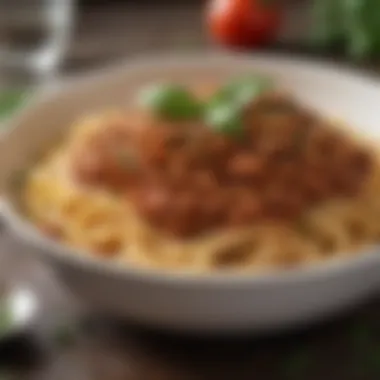
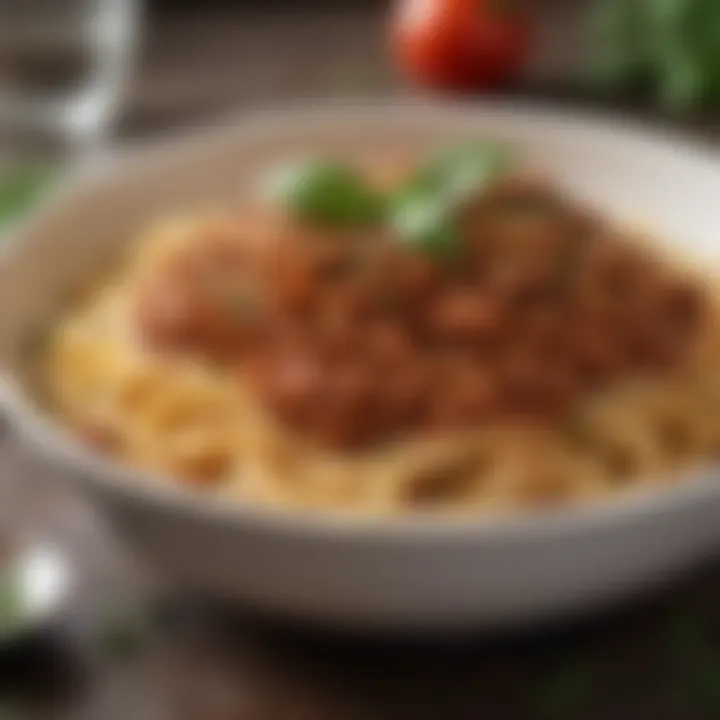
Intro
Spaghetti Bolognese, an iconic dish from Italy, has more layers to it than meets the eye. It’s a classic that’s become a staple in kitchens around the world, but the evolution and preparation of this dish are rich with history and flavor. It isn’t simply about boiling pasta and slapping some sauce on top. Instead, it encompasses a nuanced blend of ingredients, techniques, and personal flair. In this guide, we’ll explore not just how to make spaghetti bolognese, but also the cultural significance it holds, the precise selection of each ingredient, and the variations that exist.
Before we roll up our sleeves and dive into the nitty-gitty of creating a hearty plate of spaghetti bolognese, it’s vital to get a grasp on what exactly makes up this dish. The recipe is straightforward, yet the possibilities for customization are practically endless.
"A culinary masterpiece, spaghetti Bolognese is not just a meal; it’s a story, a tradition, and above all, an invitation to create."
Spaghetti Bolognese invites both seasoned chefs and eager novices to experiment and make it their own. From the basic recipe to the careful attention to each ingredient, let’s unravel the tapestry behind this beloved pasta dish.
Historical Context of Spaghetti Bolognese
Understanding the historical context of spaghetti bolognese enriches our appreciation for this culinary staple. It transcends mere sustenance, revealing intricacies of tradition, regionality, and adaptation that reflect the culture of Italy and its diaspora. The journey of this dish from the kitchens of Bologna to various tables worldwide demonstrates not only a shift in taste but also in societal values.
Origins in Italian Cuisine
Spaghetti bolognese is rooted in Italian culinary practices that date back centuries. Its origins can be traced to ragù alla bolognese, which is a slow-cooked meat sauce that forms the heart of this dish. The combination of meat, aromatics, and a blend of flavors echoes the practices of Italian grandmothers who prepared their meals with patience and love.
Historically, a similar ragù appeared in culinary texts of the 18th century. It was primarily associated with northern Italy, especially in the region of Emilia-Romagna. While our modern understanding often leans heavily towards the use of tomatoes, early versions utilized different types of meat, such as veal or even game, slowly simmered to extract a depth of flavor that is unforgettable. The original recipes indeed had a detailed character, often involving a variety of spices and local produce, all of which showcase the diversity of Italian agriculture.
Cultural Significance in Bologna
Bologna, often regarded as the gastronomic capital of Italy, plays a critical role in the cultural significance of spaghetti bolognese. The dish is more than just a meal; it’s a symbol of the rich culinary heritage of the city. The phrase "la grassa," meaning "the fat one," is often used to describe Bologna, pointing to its reputation for indulgent foods. From its street markets to family dining tables, bolognese sauce exemplifies the city’s dedication to high-quality, flavorful cuisine.
In Bologna, the tradition of savoring a dish like spaghetti bolognese goes beyond just a casual meal. It embodies a communal spirit, bringing families and friends together. Each home may have its own take on how to prepare it, perpetuating a cycle of culinary evolution. As Bologna embraced immigrant cultures, the variations on its classic ragù began to reflect those influences, leading to a global interpretation that retains its authentic roots while evolving through new tastes and techniques.
Bolognese sauce, therefore, serves not only as a delicious accompaniment but also as a narrative – a historical witness to the social fabric and culinary artistry that defines one of Italy's most beloved regions.
The following sections will explore the intricate components, preparation techniques, and cultural adaptations that make spaghetti bolognese a cherished dish worldwide.
Breaking Down the Ingredients
When discussing spaghetti bolognese, one might think the sauce is the star of the dish, but the ingredients play a far more nuanced role in the final flavor profile. Understanding the interplay of various components is essential for anyone trying to perfect their bolognese. This section explores key ingredients, which not only contribute distinct flavors but also enhance the overall character of the dish.
Types of Meat and Their Characteristics
Choosing the right meat is the bedrock of a rich bolognese. Traditionally, a mix of ground beef and pork is favored. The beef offers a robust flavor while the pork brings sweetness and fat, which creates a well-balanced sauce.
Some may experiment with ground lamb or even veal, adding layers of complexity. Fat content matters too; a leaner cut may result in a sauce that lacks depth and richness. It’s worth considering the source of the meat—local farms or butcher shops often provide fresher options than commercial brands. When sautéed, the meat should be browned properly to develop that beautiful crust, creating a base of flavor for your sauce.
The Role of Aromatics
Aromatics are like the unsung heroes of bolognese. They lay the groundwork for all subsequent flavors. The classical trio includes onions, carrots, and celery—often referred to as soffritto. When finely diced and slowly cooked in olive oil, these ingredients release their natural sugars, creating a sweet, aromatic base.
It's crucial to avoid skimping on this step. If you rush it, those flavors won't bloom and you risk losing the depth that a slow-cooked sofrito provides. Fresh garlic can also be added for an extra kick; however, ensuring it doesn’t burn is vital as burnt garlic can introduce a bitter taste.
Tomato Variants and Their Impact
Tomatoes are where one truly begins to break down the bolognese sauce's complexity. Canned San Marzano tomatoes are often touted as the best choice due to their sweetness and lower acidity. These tomatoes offer a superior flavor compared to standard varieties.
In addition to canned tomatoes, you might consider incorporating tomato paste which is concentrated and acts as a thickening agent, enhancing the sauce's richness. Diced tomatoes add texture, while passata brings smoothness. Mixing these varieties creates a balance between body and flavor intensity, ensuring that each spoonful of bolognese is a little treasure of flavor.
Pasta Selection: Beyond Spaghetti
While spaghetti is the most recognized pasta pairing with bolognese, branching out can wonderfully elevate this classic dish. Pappardelle, with its wide ribbons, provides a canvas that clings beautifully to the sauce, allowing for a more luxurious bite.
Tagliatelle is another excellent option, created with a slightly firmer texture that withstands the weight of a hearty sauce. And don’t overlook the charm of baked pasta dishes like lasagna, where the hardiness of the pasta complements the bolognese in an entirely different way. Experimenting with other shapes opens up a new world of culinary textures and experiences which can enrich your meal.
Pro Tip: Always cook your pasta al dente; it will continue to cook when combined with the sauce, preventing a mushy end product.
By breaking down each ingredient in spaghetti bolognese, you’ll better understand how they work together to create a dish far richer than the sum of its parts. Combine your bounty of meats, aromatics, tomatoes, and pasta wisely and you’re on your way to a masterpiece.
Preparation Techniques
In the realm of spaghetti bolognese, preparation techniques serve as the backbone of this beloved dish. Understanding the methods employed not only enhances flavor but also transforms the culinary experience from a mundane activity into a delightful art. Techniques dictate texture, layers of flavor, and overall harmony of the dish. Paying careful attention to these methods can elevate an average bolognese into an unforgettable meal.
Traditional Cooking Methods
Traditional cooking methods for spaghetti bolognese are steeped in history. Most commonly, this involves a slow-simmering process. The longer the sauce is cooked, the more time the flavors have to meld together and deepen. Here are some essential points regarding traditional techniques:
- Soffritto Base: The flavor journey begins with a soffritto made of finely chopped onion, celery, and carrot. This mixture is usually sautéed gently in olive oil until soft, taking care to not brown it too much. The sweetness from these veggies forms the foundation of the sauce.
- Meat Browning: Using a mix of ground meat, often beef and pork, you want to act like a maestro conducting an orchestra. Brown the meat thoroughly, allowing Maillard reactions to create a rich color and depth of flavor.
- Layered Building: Adding ingredients in stages is crucial. Once the meat is browned, deglaze the pan with wine—red or white, it doesn’t matter too much, just ensure it complements your ingredients. This also scrapes up the savory bits stuck to the pot, delivering even more flavor.
Their impact can’t be understated. A slow-cooked bolognese sauce benefits from the release of natural juices and the breakdown of connective tissues in meat, leading to a velvety texture.


"An authentic bolognese is more about patience and love than rapid-fire techniques."
Modern Adaptations and Shortcuts
However, in today’s fast-paced world, not everyone has hours to spare in the kitchen. Modern adaptations to spaghetti bolognese can still yield delicious results without compromising on quality much. Here are some popular approaches:
- Pressure Cooking: This method can significantly decrease cooking time while maintaining the depth of flavors that traditional techniques might take hours to develop. Pressure cookers trap heat and moisture, which infuses the sauce intensely.
- Convenience Products: While many purists turn their noses up at the thought, using pre-chopped vegetables or jarred sauces can streamline the process. Just make sure to add fresh herbs at the end for a bit of vibrancy and balance.
- Batch Cooking: Prepare a larger amount of bolognese and freeze portions for quick weeknight meals. This is an excellent way to enjoy a taste of tradition without the time commitment on busy days.
It’s clear that whether one opts for the slow-cooked, traditional approach or the expedient modern methods, each technique presents opportunities to personalize and perfect the signature dish. The goal remains the same: balancing the flavor while adapting to lifestyle changes.
Balancing Flavors in Bolognese Sauce
Balancing flavors in Bolognese sauce is no less than an art. It's a nuanced endeavor that can make or break the reputation of this beloved dish. Far beyond just mixing ingredients, mastering this balance can transform your spaghetti Bolognese from passable to extraordinary.
In crafting a Bolognese sauce, understanding how different tastes interplay is essential. The components that contribute to this dish—umami, acidity, sweetness—must not only coexist but also enhance one another. A well-balanced sauce can elevate your dish, making each bite a delightful experience rather than a muddled mess.
The Importance of Umami
Umami is often referred to as the "fifth taste" for good reason. It encapsulates savory flavors that deepens the dish's profile. In Bolognese, umami predominantly comes from the meat and tomatoes, but there are other ways to boost it. For instance, using parmesan cheese or even a deft sprinkle of soy sauce can enrich the base flavor. Here’s the kicker: enhancing umami isn’t just about adding more of it; it’s about layering flavors.
For those who might wonder if they need to invest in fancy ingredients to achieve this depth—fear not! Simple ingredients like mushrooms and dried herbs also pack a significant punch, introducing that elusive depth without steering the budget off course. In essence, umami draws people in; it captivates taste buds and leaves diners craving more.
Acidity and Sweetness: A Delicate Dance
The balance between acidity and sweetness is where the magic truly happens in spaghetti Bolognese. Each plays a critical role, keeping the sauce lively and inviting. Acidity, notably from tomatoes and sometimes added wine, can brighten the dish, cutting through the richness of the meat. On the flip side, sweetness can soften overpowering flavors and provide a more rounded profile.
Finding the right balance boils down to taste and personal preference. Perhaps you like a punchier sauce; adding a dash of balsamic vinegar might just do the trick. Conversely, if you're leaning on the sweeter side, a bit of carrot in your soffritto can subtly lend that necessary sweetness while avoiding an outright clash of tastes.
A dash of sugar can also work wonders here. Don’t be shy in experimenting!
"Cooking is about creating an experience rather than just assembling ingredients."
Here's an easy tip: when simmering your sauce, keep tasting and adjusting as needed. These small tweaks can dramatically affect the end result. Trust your palate and don’t fear making changes as you go. The right balance will leave you with a sauce that's both comforting and complex, embodying the heart of Italian cooking.
In summary, balancing flavors in Bolognese sauce requires attention to detail and a slightly adventurous spirit. Embrace the umami, finesse the acidity and sweetness, and before you know it, the dish will sing with flavor and warmth.
Serving Suggestions
When it comes to spaghetti bolognese, the way you serve the dish can enhance its overall appeal and influence how it is enjoyed. Consideration for toppings, presentation, and pairing with beverages creates an experience that transcends mere satisfaction of hunger. It's all about creating a moment around the meal, involving both aesthetics and flavor harmony.
Traditional Vs. Contemporary Plating
The approach to plating spaghetti bolognese can evoke a sense of nostalgia or reflect modern culinary trends. Traditional plating often involves tossing the pasta with the bolognese sauce right before serving. This method allows the sauce to cling to the strands of pasta, creating that familiar home-cooked feel.
On the other hand, contemporary plating takes a more artistic route. Here, chefs may choose to layer components separately on the plate—giving a generous twirl of spaghetti in the center topped with a dollop of sauce, a sprinkle of parmesan, and fresh basil for garnish. This not only maintains the integrity of each element but also invites diners to interact with their food, creating an engaging dining experience.
- Traditional Style:
Emphasis on comfort and authenticity. - Contemporary Style:
Highlighting the visual aspect.
- Pasta and sauce mixed together.
- Often served on larger plates.
- Topped with grated cheese at the table.
- Layered presentation with sauce on top.
- Decorative garnishes like microgreens or edible flowers.
- Smaller, elegant dishware for a fine dining feel.
These distinctions allow the dish to cater to different occasions, from a cozy family dinner to a sophisticated gathering.
Pairing with Wine and Other Accompaniments
Pairing spaghetti bolognese with the right wine can elevate the entire experience. The goal of a good wine pairing is to complement the rich, meaty flavors of the sauce while enhancing the dish's overall profile. A classic choice would be a Chianti, known for its high acidity and berry notes that work wonderfully with the tomato base.
Other notable wine options include:
- Sangiovese: Its herbal notes and vibrant acidity help cut through the richness of the dish.
- Barbera: Offers a fruity profile that mirrors the tomatoes without being overpowering.
- Montepulciano: This provides depth with its full-bodied nature, matching the boldness of the bolognese.
Apart from wine, consider serving spaghetti bolognese with some delicious accompaniments. Garlic bread, with its crunchy texture and rich flavor, adds a satisfying contrast to the dish. A simple side salad with arugula or mixed greens dressed in lemon and olive oil brings a refreshing crunch that balances the richness of the bolognese.
"Serving suggestions are not just about food—it's about creating a dining experience that engages all senses."
Lastly, don't forget the finishing touch. A sprinkle of fresh herbs or a dash of red pepper flakes can add that perfect hint of spice that'll leave diners coming back for seconds.
Exploring Variations of Bolognese
When it comes to spaghetti bolognese, the variations are as rich as the sauce itself. Exploring these variations is not just about savoring different flavors, but understanding the cultural and personal contexts that inform each one. With its roots embedded in Italian culinary tradition, spaghetti bolognese, or "ragù alla bolognese," has adapted to fit diverse palates and dietary preferences around the world. The significance of this exploration lies in acknowledging the creativity that can emerge from a time-honored dish, while still respecting the essence of its original form.
By examining the many iterations of bolognese sauce, enthusiasts and novice cooks alike can appreciate the scope of this beloved meal. Each variation not only offers a new taste experience but also invites cooks to personalize their approach, contributing to the dish’s reputation as a canvas for culinary artistry.
Vegetarian and Vegan Adaptations

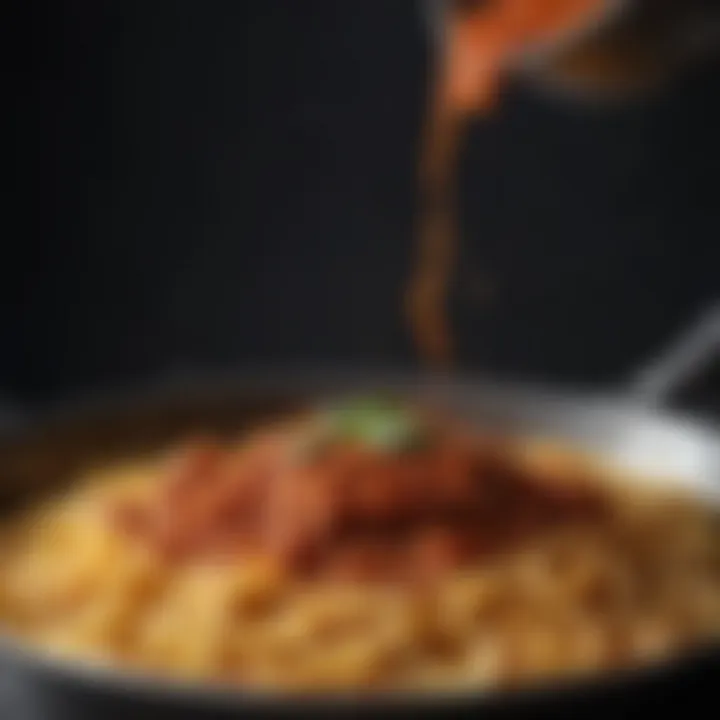
As more individuals are turning to plant-based diets, vegetarian and vegan adaptations of bolognese have emerged, appealing to a broad audience without sacrificing flavor. These adaptations capitalize on the foundational elements of the dish, such as textures and umami, while replacing meat with ingredients that can mimic or enhance the traditional experience.
- Lentils are a popular substitute, thanks to their hearty texture and ability to absorb flavors, making them an ideal base for a vegan bolognese. The earthy profile of lentils blends beautifully with tomatoes and spices, capturing the essence of the original sauce.
- Mushrooms, especially varieties like shiitake and portobello, can be diced finely and sautéed to add depth and an almost meaty quality. When combined with onions, garlic, and herbs, mushrooms can create a rich, savory sauce that sings with flavor.
- Chopped walnuts or tofu provide an additional option, introducing a crunchy texture or protein boost.
"Exploring vegan adaptations of bolognese showcases not just a shift in ingredients but a broader conversation about accessibility and sustainability in Italian cuisine."
Moreover, the adaptability doesn't stop there. Plenty of spices and herbs can be introduced to broaden the flavor palette further. A touch of smoked paprika, for example, can evoke wonder, transporting each bite to new culinary heights. Not only does this provide a fresher twist, it invites a challenging element of experimentation for those looking to reimagine spaghetti bolognese.
Regional Variations in Italy
Italy is a tapestry of cultures, and its culinary landscape reflects this diversity. As such, regional variations of bolognese exist, each providing a unique spin on the classic recipe while still holding on to its core essence. Knowing these local differences can enhance one's appreciation for the dish as a whole.
- In Emilia-Romagna, where the dish proudly hails from, the traditional recipe incorporates a blend of meats, with a focus on beef and pork, simmered low and slow. It is often enhanced with a touch of milk or cream at the end, creating a silky texture.
- Moving south, the Napolitan version may include more tomatoes, often served with a thicker consistency and combined with pasta like ziti or penne rather than spaghetti.
- Moving north, in places like Trentino-Alto Adige, you might find pumpkin or squash integrated into the sauce, creating a beautiful balance of sweetness and acidity, accompanied by dumplings or polenta instead of the traditional pasta.
These regional adaptations serve as a reminder of how a single dish can morph and evolve, taking on the characteristics of the geographic area, the available ingredients, and the traditions of its people. Each variation reflects the heart and soul of its origin, ensuring that spaghetti bolognese continues to reign as a beloved comfort food not just in Italy but around the globe.
Common Mistakes to Avoid
Spaghetti Bolognese is not just a dish; it's a canvas for culinary expression. However, the art of crafting this classic meal comes with its share of pitfalls. Recognizing common mistakes can mean the difference between a dish that simply fills a plate and one that sings with flavor and authenticity. Avoiding these missteps isn’t just beneficial—it’s crucial for harnessing the full potential of this beloved Italian staple.
Overcooking Pasta
One of the biggest blunders in making spaghetti bolognese is overcooking the pasta. Getting the pasta just right, or al dente, is critical. When you cook pasta for too long, it can turn mushy, losing that delightful bite that is essential in every forkful. Not only does it affect the texture, but it also interferes with how the sauce adheres to the pasta.
To achieve the perfect al dente, follow these pointers:
- Use Plenty of Water: Ensure you're boiling pasta in a large pot with ample water. This prevents it from sticking together.
- Salt Your Water: Adding salt enhances the flavor during cooking, imparting a savory touch to the pasta itself.
- Timing is Essential: Follow the package instructions closely but taste-test the pasta a minute or two before the recommended time. You want that slight firmness in the center.
- Immediate Drainage: Once cooked, drain the pasta without rinsing. Rinsing washes away the starch that helps the sauce cling. Even better, save a cup of the pasta water; it can be a great addition to your sauce to adjust consistency later.
"Perfectly cooked pasta is the backbone of a successful Spaghetti Bolognese. Don't let it slip through your fingers."
Neglecting the Sofrito
Another error often made in the kitchen is the neglect of sofrito, the aromatic base of a good bolognese sauce. Sofrito generally includes onions, carrots, and celery, finely chopped and sautéed to draw out their natural flavors. Skip this step, and you might as well pour the sauce out of a can.
Here’s why making a proper sofrito is so key:
- Flavor Foundation: The softening process enhances sweetness, depth, and complexity as the sugars in these ingredients caramelize.
- Cooking Temperature Matters: Start on low heat and gradually ramp it up. This allows the vegetables to soften and not burn, which can impart a bitter taste to your sauce.
- Patience is Vital: Don’t rush through this step. Taking the time to build the sofrito properly can elevate your dish to a whole new level. It’s about layering flavors that work harmoniously in the background.
Here’s a quick guideline:
- Chop onions, carrots, and celery into uniform small pieces for even cooking.
- Heat olive oil in a heavy-bottomed pot over medium-low heat.
- Add your chopped vegetables, season with a bit of salt to help draw out moisture, and stir occasionally.
- Cook until softened and fragrant, typically about 10 minutes.
Neglecting to make a proper sofrito can leave your bolognese lacking warmth and character, so make sure you give it the attention it deserves.
Nutritional Aspects of Spaghetti Bolognese
Understanding the nutritional aspects of spaghetti bolognese is crucial, especially for those who want to enjoy this rich dish while being mindful of their health. With its blend of proteins, carbs, vegetables, and fats, bolognese offers a well-rounded meal if approached thoughtfully. The balance of these elements can make this dish not just a comfort food but also a nutritious option.
Caloric Content and Nutritional Balance
When it comes to caloric content, spaghetti bolognese can be viewed through different lenses depending on ingredient choices. A typical serving contains roughly 500 to 800 calories, depending on factors like the type of meat used, the amount of pasta, and the richness of the sauce. Here’s a closer look:
- Proteins: Ground beef, pork, or a mix can provide a solid amount of protein, essential for muscle repair and overall health. Leaner cuts can help lower the total calorie count.
- Carbohydrates: Pasta, while a fundamental component, is often critiqued for being high in carbs. However, the key is in moderation. Whole-grain pasta can supply fiber while aiding digestion.
- Fats: Olive oil and cheese contribute healthy fats, but portion control is key. Opting for a sprinkle of parmesan instead of a heavy layer can significantly change the fat content.
Balancing these elements can be a game changer in nutritional terms. Think of it as a symphony, where each ingredient plays its part harmoniously to create a satisfying and nourishing meal.
Incorporating Healthy Alternatives
With a focus on health, many cooks are eager to explore healthier alternatives suitable for spaghetti bolognese. Here are some ideas to make your dish lighter and more nutritious:
- Vegetable Substitutes: Using lentils or mushrooms instead of beef can add depth and flavor without the added calories. These ingredients are great sources of fiber and nutrients.
- Whole Grains: Switching to whole grain or legume-based pasta increases fiber, which can help in feeling fuller longer and regulating blood sugar after meals.
- Low-Fat Dairy: For those who can’t live without cheese, consider low-fat mozzarella or parmesan. They provide the same taste but with less fat.
- Added Vegetables: Boost the nutritional profile by grating carrots or adding zucchini to the sauce. This not only stretches the recipe but also enhances the vitamin content.
By making these adjustments, you ensure that your spaghetti bolognese is not just a delicious experience but a nutritional powerhouse as well.
"Eating healthy doesn’t mean you have to give up your favorite foods; it’s about finding a balance and making smart choices."
The Impact of Bolognese on Modern Cuisine
The influence of Bolognese sauce on contemporary culinary practices cannot be understated. As a dish that has traversed decades and geographical boundaries, it has evolved significantly while still holding onto its traditional roots. This section explores how Bolognese has not only remained relevant but has also shaped modern cooking trends, inspiring both home cooks and professional chefs alike.
Global Interpretations of the Dish
Bolognese sauce, originally hailing from Bologna, Italy, has found a home in kitchens around the world, morphing and adapting to local tastes and preferences. In each new locale, this iconic sauce shifts into new forms, displaying a variety of global interpretations.
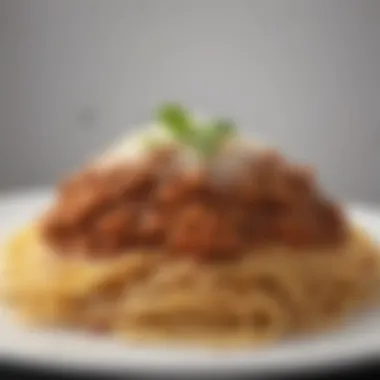
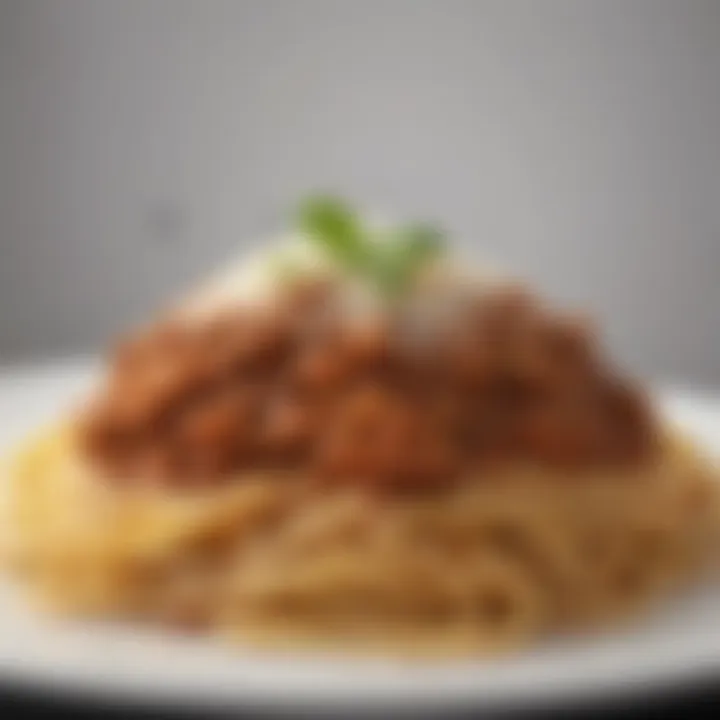
For instance, in the United States, many embrace a heartier version. Here, it's common to see Bolognese piled atop oversized portions of spaghetti, often rich in sodium and paired with a generous sprinkle of shredded cheese. On the other hand, Australian versions could feature local ingredients like kangaroo meat or an infusion of native herbs, creating a unique take on the classic dish.
Countries like Brazil have also adapted Bolognese, often incorporating spices such as cumin and garlic that cater to their culinary palate. These variations are not mere imitations; they reflect a fusion of cultures and tastes, illustrating how a traditional dish can grow and evolve without losing its essence.
"Food is not just a means to an end; it is a reflection of culture and identity, precisely what Bolognese has come to symbolize in various contexts."
Influence on Current Food Trends
The ripple effects of Bolognese are seen prominently in modern culinary trends, particularly in the rise of comfort food and pasta reinventions. As dining habits are shifting toward home-cooked meals with an emphasis on quality ingredients, Bolognese stands out as a classic that ties back to these principles. Chefs are revisiting this dish with fresh eyes, focusing on locally sourced meats, seasonal vegetables, and artisanal pasta.
Moreover, the move toward plant-based eating has led to innovative alternatives that do not compromise on flavor. Many chefs now craft vegan Bolognese variations using lentils, mushrooms, or even nuts, creating a richer depth of flavor that welcomes vegetarian eaters or those looking for healthier options. From cloud kitchens to gourmet restaurants, Bolognese is being reimagined and celebrated in ways that cater not just to taste but to health consciousness as well.
In connection to preparation methods, slow cooking has gained traction, allowing the sauce to develop a complex profile that mature palates appreciate. This backs a larger trend towards savory, fermented, and umami-rich flavors dominating menus and food blogs alike.
Ultimately, Bolognese is more than just a sauce; it's a cornerstone for many food enthusiasts eager to explore both traditional and contemporary culinary landscapes. Its adaptability and flavors speak both to the past and the future of home cooking and gourmet food alike.
Culinary Tools for the Perfect Bolognese
When it come to crafting an exquisite spaghetti bolognese, the tools you use can make a world of difference. Just like a painter needs the right brushes to express their vision, a cook requires proper equipment to bring the flavors of bolognese to life. A solid selection of culinary tools not only enhances the cooking process but also contributes to the overall taste and presentation of the dish. Let’s take a closer look at the essential cooking equipment and the knife skills that set the foundation for a stellar bolognese experience.
Essential Cooking Equipment
In cooking, having the right tools at your disposal can turn a good meal into a great one. Here's a list of some must-have items that can elevate your spaghetti bolognese preparation:
- Heavy-bottomed Pot or Dutch Oven: This is crucial for evenly distributing heat while simmering sauces. It helps prevent burning while extracting maximum flavor from your ingredients.
- Wooden Spoon: A classic choice, wooden spoons are not just traditional, they’re effective for stirring without scratching your pot.
- Colander: To drain your pasta properly, a good colander is indispensable. Look for one with small holes that can catch even the tiniest bits of pasta.
- Cutting Board: A sturdy, well-sized cutting board is essential for chopping your vegetables and meat. A wooden or bamboo board adds a nice touch to the kitchen and is gentle on your knives.
- Measuring Cups and Spoons: Precision is crucial in cooking, especially when it comes to seasoning. Having a set of measuring cups and spoons enables you to get just the right amounts of spices and liquids.
Using these tools properly can really maximize the flavors of your bolognese sauce. Now, let’s talk about the importance of knife skills in your cooking endeavors.
Recommended Knife Skills for Preparation
Being handy with a knife is not merely about speed; it’s about technique and safety. Good knife skills can make prep work efficient and enjoyable, not to mention safer. Here are some recommended knife skills to consider when making your spaghetti bolognese:
- Proper Grip: Hold your knife with a pinch grip - this means gripping the steel blade with your thumb and index finger, while your other fingers wrap around the handle. This offers better control and stability.
- Chopping Vegetables: When chopping onions, garlic, or carrots, cut them into uniform sizes. This ensures even cooking, so no one piece is over or underdone.
- Minced Ingredients: For garlic or herbs, a rock-chop motion will finely mince them. Place the flat side of the knife over the garlic or herbs while pressing down with the other hand, then rock the blade back and forth.
- Slicing Meat: If using beef, slice against the grain to keep the meat tender. Proper slicing not only affects tenderness but enhances the visual appeal of your dish as well.
"Having the right equipment and the skills to use it can create magic in the kitchen. Don't underestimate the importance these aspects hold."
Mastering these skills makes cooking far more efficient and enjoyable. Even if you’re just putting together a simple meal, the right culinary tools can give you the confidence to experiment and embellish. The next time you decide to make a hearty pot of bolognese, remember that your tools and skills play a significant role in the final product. Embrace the art of cooking with the right preparations, and savor the rewarding results.
Storing and Reheating Bolognese
When it comes to enjoying Spaghetti Bolognese, one might say that the best is yet to come after the first serve—specifically in the storing and reheating. Proper storage and reheating not only help in saving that delicious sauce for later but also play a crucial role in preserving its rich flavors and textures. Improper handling can turn a savory delight into an unappealing mess, so let’s explore how to handle your Bolognese to enjoy maximum flavor and quality over time.
Best Practices for Storage
Understanding how to store your Bolognese is not just about putting it in the fridge and forgetting it. Here are some guidelines:
- Cool Down First: Before you store your Bolognese, let it cool down to room temperature. This helps prevent condensation, which can lead to freezer burn or unwanted moisture.
- Use Airtight Containers: Invest in good quality airtight containers. These keep your Bolognese fresh and free from absorbing odors from other foods in the fridge. Glass containers are excellent as they don't stain or retain odors.
- Portion It Out: If you plan to enjoy your Bolognese on different occasions, portioning it out can make reheating simpler. This way, you can take just what you need without defrosting the whole batch.
- Labels are Key: Don’t forget to label your containers with the date. Bolognese can typically be kept in the fridge for about 3-5 days, while in the freezer it can last for up to three months. Knowing when it was stored helps you keep track of freshness.
Storing Bolognese properly allows for better flavor retention and makes meal prep easier down the line.
Reheating Techniques for Retaining Flavor
Reheating may seem straightforward, but how you do it can change the game. Here are some techniques for enhancing the flavor profile during the reheating process:
- Stovetop Method: This is often the best way to bring back the magic. Place your Bolognese in a saucepan over low heat, stirring occasionally. Add a splash of water or broth if it feels too thick. The gentle heat helps the flavors meld back together without disrupting the sauce's consistency.
- Microwave with Care: If you’re short on time, the microwave is a quick option. Transfer your Bolognese to a microwave-safe dish, cover it to retain moisture, and heat in short bursts (about 30-seconds) stirring in between. This prevents hot spots and ensures even heating.
- Add Fresh Elements: To refresh the sauce, consider adding a pinch of salt, a touch of olive oil, or even some freshly chopped herbs like basil or parsley before serving. This not only boosts flavor but can make the dish feel as good as freshly made.
"A properly reheated Bolognese can taste just as delightful as it did on the first day. Treat it well, and it will reward you with every bite."
By following these storing and reheating practices, you can enjoy your Spaghetti Bolognese more than once, all while keeping its essence alive. There’s no need to feast in silence; a well-managed Bolognese can sing the flavors of Italy long after its first cooking.
Ending: The Enduring Appeal of Spaghetti Bolognese
Spaghetti Bolognese isn’t just another dish on the menu; it’s a multifaceted tapestry woven through history, culture, and personal connections. The charm of this Italian classic has a way of pulling at the heartstrings, whether it's the comforting aroma wafting from the kitchen or the satisfying blend of flavors that dance on the palate. As we dissect the various elements that give this dish its undeniable allure, one finds that its heritage is rich with meaning and modern relevance.
"Food is a universal language; it tells stories, bridges cultures, and holds memories in every bite."
Reflections on Tradition and Innovation
When it comes to culinary arts, tradition often serves as the backbone, providing a framework on which culinary identity is built. Spaghetti Bolognese epitomizes this blend of age-old practices and contemporary experimentation. In Bologna, the heart of this dish, family recipes are passed down through generations, each adding a twist or personal touch that reflects not only the evolving palate but also the changing times.
Take the age-old method of slow cooking. While it reverberates with tradition, today's world allows for quicker alternatives. More people are switching to pressure cookers or even slow-cooker variations. It’s fascinating how the essence of the original meal remains intact, despite the shift in preparation methods. Adaptation does not erase the past; rather, it honors it by keeping the dish alive in a rapidly changing culinary landscape.
Interestingly, many new ingredients have entered the scene, too. Ingredients like quinoa or zoodles (zucchini noodles) offer a fresh take on a classic dish, inviting those who might be health-conscious or looking for gluten-free options to partake in the joy of Bolognese. These innovations don’t diminish the traditional roots; they merely broaden the appeal, making the dish accessible to a wider audience.
Invitation to Personal Exploration
Getting hands-on with the art of cooking Spaghetti Bolognese is an invitation to embark on a culinary journey that’s uniquely yours. The beauty of this dish lies in its inherent flexibility. While the classic recipe sets the guidelines, there’s no one-size-fits-all approach; each cook can leave their mark through personal choices.
One could start with traditional ground beef or explore turkey or a medley of mushrooms for a vegetarian take. Spices, herbs, and even the type of wine used can be swapped out to reflect personal preferences. This aspect of the dish not only encourages creativity, but it also becomes a way for people to share their own stories.
When you prepare Spaghetti Bolognese, you’re also crafting memories. Maybe it’s a dish associated with Sunday dinners or a meal prepared during cozy winter nights. The process allows for individual reflections—those food-centered moments of family gatherings or solo cooking sessions that can rejuvenate the spirit. In essence, you’re not just making a meal; you’re building a tradition, one plate at a time.







